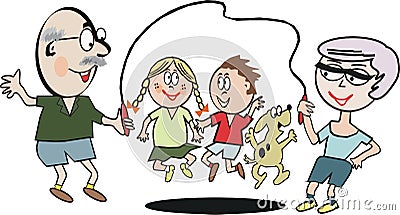With the rapid rate of development in technology, computers,
iPads, Play Station, amongst others, children tend to stay indoors and do as
much as they can sitting at a computer, including entertainment. Before such
technological gadgets existed or weren't so readily available, children were
forced to go outside and play with a soccer ball to entertain themselves.
Because it was a game, children did not see this as exercise; it was merely
playtime. However, they were reaping the benefits of an active lifestyle. Now,
physical activity has to be planned and thus is seen as a torturous hour of the
day that is a hassle and very unpleasant. Thus, many children look for every
excuse not to do it.
Childhood Obesity
Childhood obesity has become a major health problem over the
past few decades. According to the CDC (Centres for Disease Control and
Prevention): “obesity has more than doubled in children and tripled in
adolescents in the past 30 years”.
Childhood obesity poses numerous health risks:
·
Increased risk for developing heart disease,
including high blood pressure and high cholesterol
·
Increased risk for developing diabetes
·
Increased risk for developing bone and joint
problems
·
Social and psychological effects, such as
stigmatization and poor self-esteem
Childhood obesity is easily preventable if appropriate
lifestyle choices are made, such as a healthy, well-balanced diet, together
with adequate regular physical activity.
Societal Changes
Changes in society have influenced our ability to keep
active and stay healthy. Parents work late, so healthy, home-cooked meals have
been replaced by fast-foods. We drive everywhere, instead of walking or riding
because of security concerns. Television and computer games have become far
more attractive than physical play. We live in smaller homes where little or no
garden is a common feature. Parents no longer have time to play with their
children. Despite these changes, a plan can always be made to keep active, such
as going to the local park and playing with your children on weekends or making
time during the week to do so. We must stop looking for excuses and rather look
for solutions!
How much physical activity should one do?
It is recommended by the American College of Sports Medicine
(ACSM) for adults to do 150 minutes of aerobic activity per week. This equates
to a 30 minute brisk walk 5 days per week. Children should participate in 60
minutes of physical activity per day, at least 5 days per week. It is most
beneficial to do a little bit of exercise on most days of the week, than to
walk for three hours on one day of the week. For children, the obvious place to
be physically active is at school – play during break time and participate in
sports after school.
Developmental Stages and Physical Activity
Regular physical activity throughout the developmental years
helps to build gross and fine motor skills, stamina, strength, cardiovascular
fitness, spatial awareness, balance and co-ordination.
Ages 5-7
·
Focus is on body management and control
·
Development of large muscle groups
·
Development of hand-eye co-ordination and
perceptual abilities, balance, co-ordination, spatial judgement, and
directional movement
·
Identification of body parts
·
Short attention span – small group activities
Ages 8-11
·
Refinement of fundamental skills
·
Start to learn to perform specialized skills
·
Explore, experiment and create activities
·
Move towards team play
·
More co-operation with peers
·
Develop an interest in sports
·
Learn more about activity patterns
·
Very active at this age
·
Longer attention span
·
Develop the desire to excel and seek recognition
for their achievements
Ages 12-18
·
More emphasis on specialized skills and sport
activities
·
Technical aspects of sport, such as rules and
game strategies, become more important
·
Team and individual sports may appeal, with a
desire for recognition of achievements
·
Consider gender differences and puberty
Parents’ Role
·
Set the example by being physically active
yourselves
·
Take time to learn about healthy dietary and
exercise choices for yourselves and your families
·
Play WITH your kids
·
Limit television and computer time to no more
than 2 hours per day and encourage outdoor playtime every day
·
Show interest by watching their school sports
fixtures – offer praise and encouragement
·
Get involved in school and community sports
programmes
·
Encourage your children to be physically active
at home – play in the garden
·
Provide transport to extra-murals
·
Make physical activity part of your lifestyle,
so that your children learn to live an active lifestyle from a young age
References
American College of Sports Medicine (2006). ACSM’s Guidelines for Exercise Testing and
Prescription (7th ed.). Philadelphia: Lippincott Williams &
Wilkins.
Roux, J.C. (2011). Curriculum
Development: Post-Graduate Certificate in Education (FET) Mathematics and
Physical Education. University of Johannesburg: Department of Sport and
Movement Studies.

